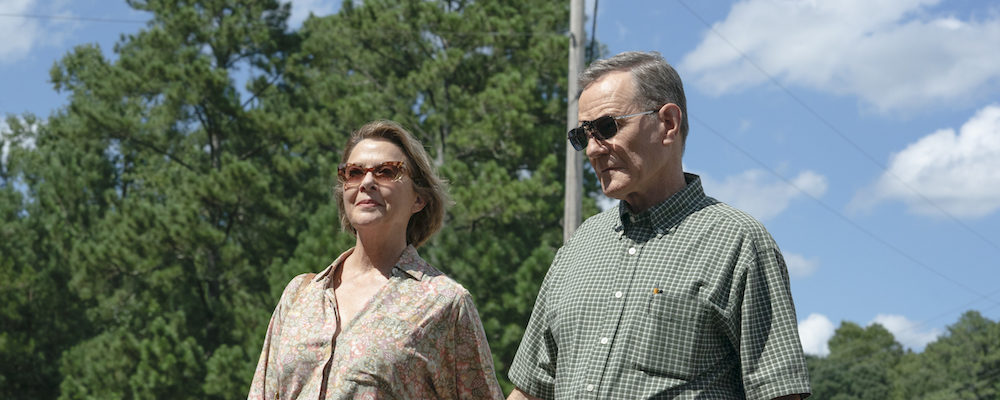‘Jerry and Marge Go Large’ Gives Tips for a Caper So Clean, You’ll Want to Try It at Home
Tony Sokol
You gotta be in it to win it, and “Jerry and Marge Go Large” proves the biggest payouts come when more are merrier. While most lotteries favor the house to win, the odds can be tipped for the home team. Paramount+’s feature comedy tells the true story of Jerry and Marge Selbee (Bryan Cranston and Annette Bening), who won millions of dollars through a mathematical loophole in the lottery, but it doesn’t feel like much of a gamble.
The 2003 origin story happened in Evart, Michigan, when the Michigan Lottery ran a game called Windfall, worth up to about $2 million when all the numbers clicked into place. Jerry was a puzzle-solver, and as OCD as Cranston’s Hal on “Malcolm in the Middle,” who kept spare encyclopedias around the house in case he had a craving to fill in all the rounded letters. Jerry’s thought process is custom made to find numerical irregularities in the most mundane settings. He brought this understanding to his day job, and was made the head of his line at the cereal factory.
It appears Annette Bening took the role of Marge for the fun of it. She finds joy in the smallest of payoffs and glee at the hints of danger. This is a very realistically played romantic role for a demographic mostly underused: long-time married couples who know there is more out there than budgets or time may allow.
“Jerry and Marge Go Large” is a family film, which has a made-for-television feel to it. It is the American dream turned into a suburban fairy tale which pays the fortune forward. The Selbees are a small-town retired couple who decide to have an adventure rather than get in each other’s way at home. Jerry shuffles some numbers and realizes the state lottery can be rigged if you buy enough tickets. But rather than turn this into a crime caper, director David Frankel finds a feel-good groove, which becomes a civics lesson, at the cost of any real peril.
The film is at its most fun when it allows Jerry to lean into the Bryan Cranston mythos. Jerry is no Heisenberg, but when he starts piling large stacks of folding cast, the audience is primed for the big numbers. Like Walter White on “Breaking Bad,” Gerald’s got a knack for minutia, and makes it count. When the state closes down the lottery, he doesn’t assemble a crack team of mercenary market chasers. He puts together a gang of shareholders in a legitimate company, and feeds lottery machines by hand. The interesting thing is they never hit the big number. Over nine years, the conglomerate wins $27 million, but pulls a profit of $7.75 million, on which they pay taxes. They are no criminals. We only want them to be.
Larry Wilmore plays the nicest guy on the planet, a recently widowed accountant who gets caught up in all the excitement with none of physical exertion. He is there to keep the happy story grounded in the most identifiably affable ways. Wilmore cuts the treacle without a single sour note, by sheer force of his effortless likeability. The convenience store clerk, played by Rainn Wilson, goes in another direction, but never so far as to tip the story into anything less than clean family fun with soiled cheese topping.
Any film about a game of chance needs a risk, and Jerry is too good at management for the film to rise to any level of real danger. The stakes are never high enough to feel like any harm or foul might befall the characters. When the state gets hip to the game, the newly large couple go on the road. A second flaw in mathematics turns into a partnership with the lottery. Even the villains never rise beyond comedic concern. An Ivy League cabal also figures out a way to legally hack the lottery, but they are downgraded to a low-level threat after a stern talking to from the father figure in the film.
The biggest gamble comes after the feeblest attempts at statistical overrun. The flaw in Windfall only kicks in after a certain number of tickets are bought. Jerry moves his way up to buying 360,000 tickets worth $720,000 in a single play before he tips the odds enough to go large. The veiled threats of violence and blackmail from the junior varsity players feel more out of place than from a dark place, and ultimately are an afterthought too quickly forgotten.
“Jerry and Marge Go Large” is more about brilliance than a get rich quick scheme. It is community minded, and presents as positive a role model as any Golden Age Frank Capra comedy. There is nothing controversial about public works paid for by state institutions constructed to exploit the poor. It is cotton candy drama, with an undercurrent of quirk comedy, but not unpleasant. That would have tipped the odds.
“Jerry and Marge Go Large” begins streaming June 17 on Paramount+.

